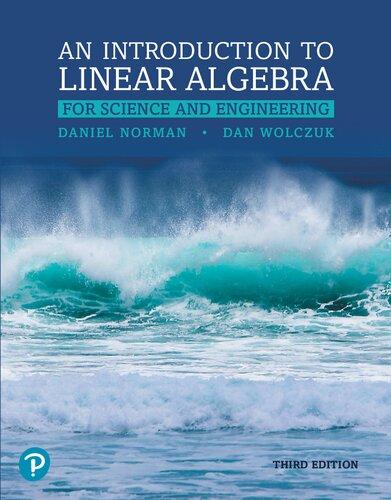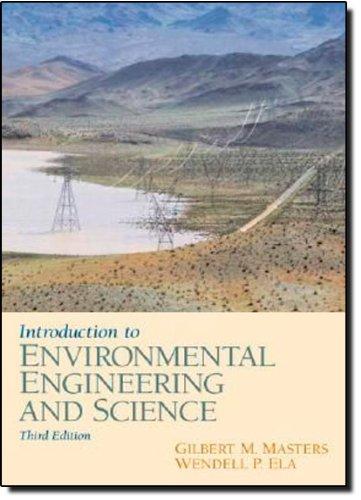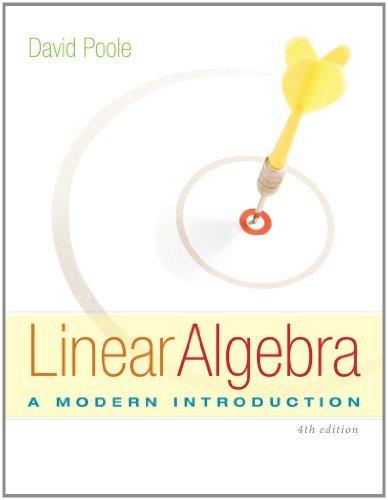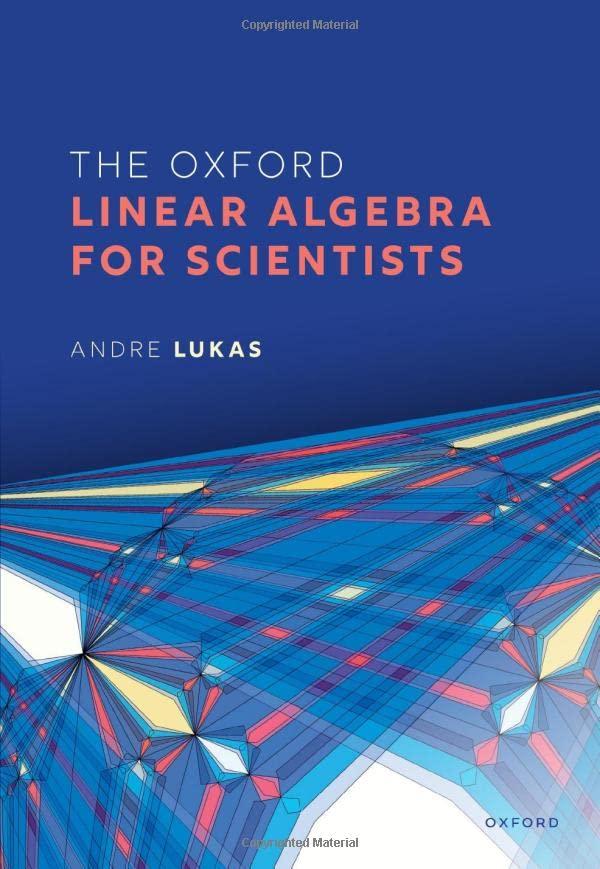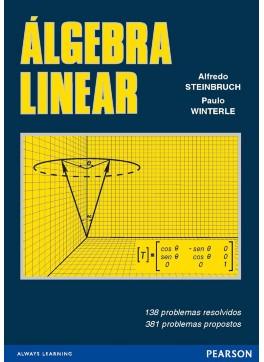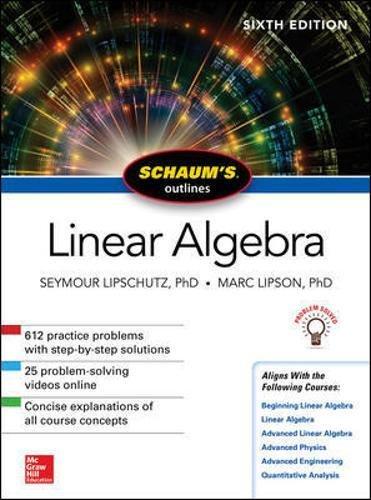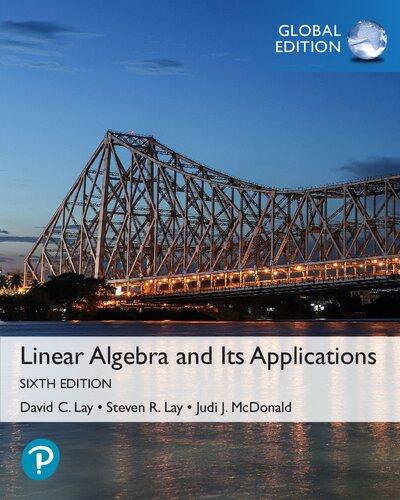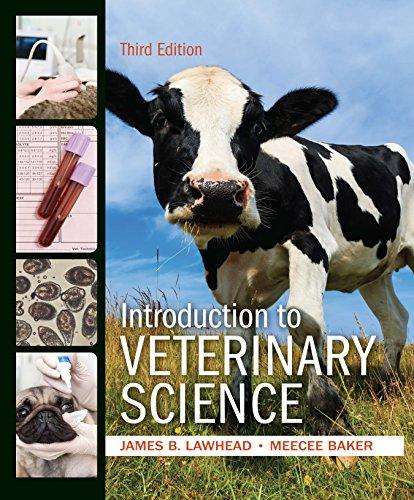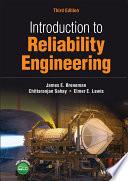Visit to download the full and correct content document: https://ebookmass.com/product/introduction-to-linear-algebra-for-science-and-engine ering-3rd-edition-daniel-norman/
More products digital (pdf, epub, mobi) instant download maybe you interests ...
Introduction to Linear Algebra for Science and Engineering 2nd Edition (Student Edition) Edition
Daniel Norman
https://ebookmass.com/product/introduction-to-linear-algebra-forscience-and-engineering-2nd-edition-student-edition-editiondaniel-norman/
Introduction to Environmental Engineering and Science 3rd Edition Gilbert M. Masters
https://ebookmass.com/product/introduction-to-environmentalengineering-and-science-3rd-edition-gilbert-m-masters/
Linear Algebra: A Modern Introduction 4th Edition, (Ebook PDF)
https://ebookmass.com/product/linear-algebra-a-modernintroduction-4th-edition-ebook-pdf/
The Oxford Linear Algebra for Scientists Andre Lukas
https://ebookmass.com/product/the-oxford-linear-algebra-forscientists-andre-lukas/
Algebra Linear 2nd Edition Alfredo Steinbruch https://ebookmass.com/product/algebra-linear-2nd-edition-alfredosteinbruch/
Linear Algebra 6th Edition Seymour Lipschutz https://ebookmass.com/product/linear-algebra-6th-edition-seymourlipschutz/
Linear Algebra and Its Applications, Global Edition Lay https://ebookmass.com/product/linear-algebra-and-itsapplications-global-edition-lay/
Introduction to Veterinary Science 3rd Edition, (Ebook PDF) https://ebookmass.com/product/introduction-to-veterinaryscience-3rd-edition-ebook-pdf/
Introduction to Reliability Engineering 3rd Edition James E. Breneman
https://ebookmass.com/product/introduction-to-reliabilityengineering-3rd-edition-james-e-breneman/
AN INTRODUCTION TO LINEAR ALGEBRA FOR SCIENCE AND ENGINEERING DANIEL NORMAN • DAN WOLCZUK THIRD EDITION
An Introduction to Linear Algebra for Science and Engineering Daniel Norman Dan Wolczuk
Third Edition University of Waterloo
PearsonCanadaInc.,26PrinceAndrewPlace,NorthYork,OntarioM3C2H4.
Copyright c 2020,2012,2005PearsonCanadaInc.Allrightsreserved.
PrintedintheUnitedStatesofAmerica.Thispublicationis protectedbycopyright,andpermissionshouldbeobtainedfrom thepublisherpriortoanyprohibitedreproduction,storageinaretrievalsystem,ortransmissioninanyformorbyanymeans, electronic,mechanical,photocopying,recording,orotherwise.Forinformationregardingpermissions,requestforms,andthe appropriatecontacts,pleasecontactPearsonCanada’sRightsandPermissionsDepartmentbyvisiting www.pearson.com/ca/en/contact-us/permissions.html.
Usedbypermission.Allrightsreserved.ThiseditionisauthorizedforsaleonlyinCanada.
Attributionsofthird-partycontentappearontheappropriatepagewithinthetext.
Coverimage: c TamasNovak/EyeEm/GettyImages.
PEARSONisanexclusivetrademarkownedbyPearsonCanadaInc.oritsaffiliatesinCanadaand/orothercountries.
Unlessotherwiseindicatedherein,anythirdpartytrademarksthatmayappearinthisworkarethepropertyoftheirrespective ownersandanyreferencestothirdpartytrademarks,logos, orothertradedressarefordemonstrativeordescriptivepurposes only.Suchreferencesarenotintendedtoimplyanysponsorship,endorsement,authorization,orpromotionofPearsonCanada productsbytheownersofsuchmarks,oranyrelationshipbetweentheownerandPearsonCanadaoritsaffiliates,authors, licensees,ordistributors.
IfyoupurchasedthisbookoutsidetheUnitedStatesorCanada,youshouldbeawarethatithasbeenimportedwithoutthe approvalofthepublisherortheauthor.
9780134682631
120
LibraryandArchivesCanadaCataloguinginPublication
Norman,Daniel,1938-,author Introductiontolinearalgebraforscienceandengineering / Daniel Norman,DanWolczuk,UniversityofWaterloo.–Thirdedition.
ISBN978-0-13-468263-1(softcover)
1.Algebras,Linear–Textbooks.2.Textbooks.I.Wolczuk,Dan, 1972-,authorII.Title.
QA184.2.N672018 512’.5 C2018-906600-8
2.3
CHAPTER3
CHAPTER4
4.1
4.5 GeneralLinearMappings..................................................................273
4.7 IsomorphismsofVectorSpaces.........................
CHAPTER5 Determinants....................................... 5.1 DeterminantsinTermsofCofactors........................................................307
5.2 PropertiesoftheDeterminant..............................................................317
5.3 InversebyCofactors,Cramer’sRule....................
5.4 Area,Volume,andtheDeterminant.........................................................337
CHAPTER6 EigenvectorsandDiagonalization.....................
6.1 EigenvaluesandEigenvectors.........................
6.2 Diagonalization....................................
6.3
CHAPTER7 InnerProductsandProjections.......................383 7.1 OrthogonalBasesin
7.2 ProjectionsandtheGram-SchmidtProcedure.............
7.3 MethodofLeastSquares...............................
7.4 InnerProductSpaces......................................................................410 7.5 FourierSeries......................................
CHAPTER8 SymmetricMatricesandQuadraticForms............425 8.1 DiagonalizationofSymmetricMatrices.....................................................425
8.2 QuadraticForms..........................................................................431
8.3 GraphsofQuadraticForms................................................................439
8.4 ApplicationsofQuadraticForms.......................
8.5 SingularValueDecomposition.........................
CHAPTER9 ComplexVectorSpaces...............................465 9.1 ComplexNumbers.....................................
9.2 SystemswithComplexNumbers..........................
9.3 ComplexVectorSpaces................................
9.4 ComplexDiagonalization.............................
9.5 UnitaryDiagonalization...................................................................500
This page intentionally left blank
ANotetoStudents LinearAlgebra–WhatIsIt? Welcometothethirdeditionof AnIntroductiontoLinearAlgebraforScienceandEngineering!Linearalgebraisessentiallythestudyofvectors,matrices,andlinearmappings,andisnowanextremelyimportanttopic inmathematics.Itsapplicationandusefulnessinavariety ofdifferentareasisundeniable.Itencompasses technologicalinnovation,economicdecisionmaking,industrydevelopment,andscientificresearch.Weare literallysurroundedbyapplicationsoflinearalgebra.
Mostpeoplewhohavelearnedlinearalgebraandcalculusbelievethattheideasofelementarycalculus (suchaslimitsandintegrals)aremoredifficultthanthoseofintroductorylinearalgebra,andthatmostproblemsencounteredincalculuscoursesareharderthanthosefoundinlinearalgebracourses.So,atleastbythis comparison,linearalgebraisnothard.Still,somestudentsfindlearninglinearalgebrachallenging.Wethink twofactorscontributetothedifficultysomestudentshave.
First,studentsdonotalwaysseewhatlinearalgebraisgood for.Thisiswhyitisimportanttoreadthe applicationsinthetext–evenifyoudonotunderstandthemcompletely.Theywillgiveyousomesenseof wherelinearalgebrafitsintothebroaderpicture.
Second,mathematicsisoftenmistakenlyseenasacollectio nofrecipesforsolvingstandardproblems. Studentsareoftenuncomfortablewiththefactthatlinearalgebrais“abstract”andincludesalotof“theory.” However,studentsneedtorealizethattherewillbenolong-termpayoff insimplymemorizingtherecipes–computerscarrythemoutfarfasterandmoreaccuratelythan anyhuman.Thatbeingsaid,practicingthe proceduresonspecificexamplesisoftenanimportantsteptowardsamuchmoreimportantgoal:understandingthe concepts usedinlinearalgebratoformulateandsolveproblems,andlearningtointerprettheresultsof calculations.Suchunderstandingrequiresustocometotermswithsometheory.Inthistext,whenworking throughtheexamplesandexercises–whichareoftensmall–keepinmindthatwhenyoudoapplythese ideaslater,youmayverywellhaveamillionvariablesandamillionequations,butthetheoryandmethods remainconstant.Forexample,Google’sPageRanksystemusesamatrixthathasthirtybillioncolumnsand thirtybillionrows–youdonotwanttodothatbyhand! Whenyouaresolvingcomputationalproblems, alwaystrytoobservehowyourworkrelatestothetheoryyouhavelearned.
Mathematicsisusefulinsomanyareasbecauseitis abstract :thesamegoodideacanunlocktheproblemsofcontrolengineers,civilengineers,physicists,socialscientists,andmathematiciansbecausetheidea hasbeenabstractedfromaparticularsetting.Onetechniquesolvesmanyproblemsbecausesomeonehas establisheda theory ofhowtodealwiththesekindsofproblems. Definitions arethewaywetrytocapture importantideas,and theorems arehowwesummarizeusefulgeneralfactsaboutthekindofproblemsweare studying. Proofs notonlyshowusthatastatementistrue;theycanhelpusunderstandthestatement,giveus practiceusingimportantideas,andmakeiteasiertolearna givensubject.Inparticular,proofsshowushow ideasaretiedtogether,sowedonothavetomemorizetoomany disconnectedfacts.
Manyoftheconceptsintroducedinlinearalgebraarenaturalandeasy,butsomemayseemunnaturaland “technical”tobeginners.Donotavoidtheseseeminglymore difficultideas;useexamplesandtheoremstosee howtheseideasareanessentialpartofthestoryoflinearalgebra.Bylearningthe“vocabulary”and“grammar”oflinearalgebra,youwillbeequippingyourselfwithconceptsandtechniquesthatmathematicians, engineers,andscientistsfindinvaluablefortacklinganextraordinarilyrichvarietyofproblems.
LinearAlgebra–WhoNeedsIt? Mathematicians Linearalgebraanditsapplicationsareasubjectofcontinuingresearch.Linearalgebraisvitaltomathematics becauseitprovidesessentialideasandtoolsinareasasdiverseasabstractalgebra,differentialequations, calculusoffunctionsofseveralvariables,differentialgeometry,functionalanalysis,andnumericalanalysis.
Engineers
Supposeyoubecomeacontrolengineerandhavetodesignorupgradeanautomaticcontrolsystem.The systemmaybecontrollingamanufacturingprocess,orperhapsanairplanelandingsystem.Youwillprobably startwithalinearmodelofthesystem,requiringlinearalgebraforitssolution.Toincludefeedbackcontrol, yoursystemmusttakeaccountofmanymeasurements(fortheexampleoftheairplane,position,velocity, pitch,etc.),anditwillhavetoassessthisinformationveryrapidlyinordertodeterminethecorrectcontrol responses.AstandardpartofsuchacontrolsystemisaKalman-Bucyfilter,whichisnotsomuchapiece ofhardwareasapieceofmathematicalmachineryfordoingtherequiredcalculations.Linearalgebraisan essentialpartoftheKalman-Bucyfilter.
Ifyoubecomeastructuralengineeroramechanicalengineer,youmaybeconcernedwiththeproblem ofvibrationsinstructuresormachinery.Tounderstandthe problem,youwillhavetoknowabouteigenvalues andeigenvectorsandhowtheydeterminethenormalmodesofoscillation.Eigenvaluesandeigenvectorsare someofthecentraltopicsinlinearalgebra.
Anelectricalengineerwillneedlinearalgebratoanalyzecircuitsandsystems;acivilengineerwillneed linearalgebratodetermineinternalforcesinstaticstructuresandtounderstandprincipalaxesofstrain.
Inadditiontothesefairlyspecificuses,engineerswillalsofindthattheyneedtoknowlinearalgebrato understandsystemsofdifferentialequationsandsomeaspectsofthecalculusoffunctionsoftwoormore variables.Moreover,theideasandtechniquesoflinearalg ebraarecentraltonumericaltechniquesforsolving problemsofheatandfluidflow,whicharemajorconcernsinmechanicalengineering.Also,theideasoflinear algebraunderlieadvancedtechniquessuchasLaplacetransformsandFourieranalysis.
Physicists Linearalgebraisimportantinphysics,partlyforthereasonsdescribedabove.Inaddition,itisvitalinapplicationssuchastheinertiatensoringeneralrotatingmotion.Linearalgebraisanabsolutelyessentialtoolin quantumphysics(where,forexample,energylevelsmaybedeterminedaseigenvaluesoflinearoperators) andrelativity(whereunderstandingchangeofcoordinates isoneofthecentralissues).
LifeandSocialScientists Input-outputmodels,describedbymatrices,areoftenused ineconomicsandothersocialsciences.Similar ideascanbeusedinmodelingpopulationswhereoneneedstokeeptrackofsub-populations(generations,for example,orgenotypes).Inallsciences,statisticalanaly sisofdataisofagreatimportance,andmuchofthis analysisuseslinearalgebra.Forexample,themethodofleastsquares(forregression)canbeunderstoodin termsofprojectionsinlinearalgebra.
ManagersandOtherProfessionals Allmanagersneedtomakedecisionsaboutthebestallocatio nofresources.Enormousamountsofcomputer timearoundtheworldaredevotedtolinearprogrammingalgorithmsthatsolvesuchallocationproblems.In industry,thesamesortsoftechniquesareusedinproduction,networking,andmanyotherareas.
Whoneedslinearalgebra?Almosteverymathematician,engineer,scientist,economist,manager,orprofessionalwillfindlinearalgebraanimportantanduseful.So,whoneedslinearalgebra?Youdo!
Willtheseapplicationsbeexplainedinthisbook?
Unfortunately,mostoftheseapplicationsrequiretoomuch specializedbackgroundtobeincludedinafirstyearlinearalgebrabook.Togiveyouanideaofhowsomeoftheseconceptsareapplied,awidevarietyof applicationsarementionedthroughoutthetext.Youwillgettoseemanymoreapplicationsoflinearalgebra inyourfuturecourses.
HowToMaketheMostofThisBook:SQ3R TheSQ3RreadingtechniquewasdevelopedbyFrancisRobinsontohelpstudentsreadtextbooksmoreeffectively.Hereisabriefsummaryofthispowerfulmethodforlearning.Itiseasytolearnmoreaboutthisand othersimilarstrategiesonline.
Survey: Quicklyskimoverthesection.Makenoteofanyheadingorboldfacewords.Readoverthedefinitions,thestatementoftheorems,andthestatementofexamplesorexercises(donotreadproofsorsolutions atthistime).Also,brieflyexaminethefigures.
Question: Makeapurposeforyourreadingbywritingdowngeneralquestionsabouttheheadings,boldfacewords,definitions,ortheoremsthatyousurveyed.Forexample,acoupleofquestionsforSection1.1 couldbe:
Howdoweusevectorsin R2 and R3 ?
HowdoesthismaterialrelatetowhatIhavepreviouslylearned?
Whatistherelationshipbetweenvectorsin R2 anddirectedlinesegments? Whatarethesimilaritiesanddifferencesbetweenvectorsandlinesin R2 andin R3 ?
Read:
Readthematerialinchunksofaboutonetotwopages.Readcarefullyandlookfortheanswersto yourquestionsaswellaskeyconceptsandsupportingdetails. Takethetimetosolvethemid-sectionexercises beforereadingpastthem.Also,trytosolveexamplesbefore readingthesolutions,andtrytofigureoutthe proofsbeforeyoureadthem.Ifyouarenotabletosolvethem,lookcarefullythroughthe providedsolution tofigureoutthestepwhereyougotstuck.
Recall:
Asyoufinisheachchunk,putthebookasideandsummarizetheimportantdetailsofwhatyou havejustread.Writedowntheanswerstoanyquestionsthatyoumadeandwritedownanyfurtherquestions thatyouhave.Thinkcriticallyabouthowwellyouhaveunderstoodtheconcepts,andifnecessary,goback andrereadapartordosomerelevantendofsectionproblems.
Review: Thisisanongoingprocess.Onceyoucompleteanentiresection,gobackandreviewyournotes andquestionsfromtheentiresection.Testyourunderstandingbytryingtosolvetheend-of-sectionproblems withoutreferringtothebookoryournotes.Repeatthisagainwhenyoufinishanentirechapterandthenagain inthefutureasnecessary.
Yes,youaregoingtofindthatthismakesthereadinggomuchslowerforthefirstcoupleofchapters.However, studentswhousethistechniqueconsistentlyreportthattheyfeelthattheyendupspendingalotlesstime studyingforthecourseastheylearnthematerialsomuchbetteratthebeginning,whichmakesfutureconcepts mucheasiertolearn.
ANotetoInstructors Welcometothethirdeditionof AnIntroductiontoLinearAlgebraforScienceandEngineering!Thanksto thefeedbackIhavereceivedfromstudentsandinstructorsaswellasmyownresearchintothescienceof teachingandlearning,Iamveryexcitedtopresenttoyouthisnewandimprovedversionofthetext.Overall, IbelievethemodificationsIhavemadecomplementmyoverall approachtoteaching.Ibelieveinintroducing thestudentsslowlytodifficultconceptsandhelpingstudentslearntheseconceptsmoredeeplybyexposing themtothesameconceptsmultipletimesoverspacedinterva ls.
OneaspectofteachinglinearalgebrathatIfindfascinating isthatsomanydifferentapproachescanbe usedeffectively.Typically,thebiggestdifferencebetweenmostcalculustextbooksiswhethertheyhave early orlatetranscendentals.However,linearalgebratextbooksandcoursescanbedoneinawidevarietyoforders. Forexample,inChinaitisnotuncommontobeginanintroductorylinearalgebracoursewithdeterminants andnotcoversolvingsystemsoflinearequationsuntilaftermatricesandgeneralvectorspaces.Examination oftheadvantagesanddisadvantagesofavarietyofthesemethodshasledmetomycurrentapproach.
Itiswellknownthatstudentsoflinearalgebratypicallyfindthecomputationalproblemseasybuthave greatdifficultyinunderstandingorapplyingtheabstractconceptsandthetheory.However,withmyapproach, Ifindnotonlythatveryfewstudentshavetroublewithconceptslikegeneralvectorspacesbutthattheyalso retaintheirmasteryofthelinearalgebracontentintheirupperyearcourses.
AlthoughIhavefoundmyapproachtobeverysuccessfulwithmystudents,Iseethevalueinamultitude ofotherwaysoforganizinganintroductorylinearalgebracourse.Therefore,Ihavetriedtowritethisbook toaccommodateavarietyoforders.SeeUsingThisTextToTeachLinearAlgebrabelow.
ChangestotheThirdEdition • Someofthecontenthasbeenreorderedtomakeevenbetteruse ofthespacingeffect.Thespacing effectisawellknownandextensivelystudiedeffectfrompsychology,whichstatesthatstudentslearn conceptsbetteriftheyareexposedtothesameconceptmultipletimesoverspacedintervalsasopposed tolearningitallatonce.See:
Dempster,F.N.(1988). Thespacingeffect:Acasestudyinthefailuretoapplytheresultsof psychologicalresearch. AmericanPsychologist,43(8),627–634.
Fain,R.J.,Hieb,J.L.,Ralston,P.A.,Lyle,K.B.(2015,June), CantheSpacing EffectImprovetheEffectivenessofaMathInterventionCourseforEngineeringStudents? Paperpresentedat2015ASEEAnnualConference&Exposition,Seattle,Washington.
• Thenumberandtypeofapplicationshasbeengreatlyincreasedandareusedeithertomotivatethe needforcertainconceptsordefinitionsinlinearalgebra,ortodemonstratehowsomelinearalgebra conceptsareusedinapplications.
• Agreateremphasishasbeenplacedonthegeometryofmanyconcepts.Inparticular,Chapter1has beenreorganizedtofocusonthegeometryoflinearalgebrain R2 and R3 beforeexploring Rn
• Numeroussmallchangeshavebeenmadetoimprovestudentcomprehension.
ApproachandOrganization Studentsoflinearalgebratypicallyhavelittletroublewithcomputationalquestions,buttheyoftenstruggle withabstractconceptsandproofs.Thisisproblematicbecausecomputersperformthecomputationsinthe vastmajorityofrealworldapplicationsoflinearalgebra. Humanusers,meanwhile,mustapplythetheory totransformagivenproblemintoalinearalgebracontext,inputthedataproperly,andinterprettheresult correctly.
Theapproachofthisbookisbothtousethespacingeffectandtomixtheoryandcomputationsthroughout thecourse.Additionally,itusesrealworldapplicationstobothmotivateandexplaintheusefulnessofsome oftheseeminglyabstractconcepts,anditusesthegeometry oflinearalgebrain R2 and R3 tohelpstudents visualizemanyoftheconcepts.Thebenefitsofthisapproach areasfollows:
• Itpreventsstudentsfrommistakinglinearalgebraasveryeasyandverycomputationalearlyinthe course,andthengettingoverwhelmedbyabstractconceptsandtheorieslater.
• Itallowsimportantlinearalgebraconceptstobedeveloped andextendedmoreslowly.
• Itencouragesstudentstousecomputationalproblemstohelpthemunderstandthetheoryoflinear algebraratherthanblindlymemorizealgorithms.
• Ithelpsstudentsunderstandtheconceptsandwhytheyareuseful.
Oneexampleofthisapproachisourtreatmentoftheconcepts ofspanningandlinearindependence.They arebothintroducedinSection1.2in R2 and R3 ,wheretheyaremotivatedinageometricalcontext.Theyare expandedtovectorsin Rn inSection1.4,andusedagainformatricesinSection3.1and polynomialsin Section4.1,beforetheyarefinallyextendedtogeneralvectorspacesinSection4.2.
Otherfeaturesofthetext’sorganizationinclude
• Theideaoflinearmappingsisintroducedearlyinageometricalcontext,andisusedtoexplainaspects ofmatrixmultiplication,matrixinversion,featuresofsystemsoflinearequations,andthegeometryof eigenvaluesandeigenvectors.Geometricaltransformatio nsprovideintuitivelysatisfyingillustrations ofimportantconcepts.
• Topicsareorderedtogivestudentsachancetoworkwithconceptsinasimplersettingbeforeusing theminamuchmoreinvolvedorabstractsetting.Forexample,beforereachingthedefinitionofa vectorspaceinSection4.2,studentswillhaveseenthetenvectorspaceaxiomsandtheconceptsof linearindependenceandspanningforthreedifferentvectorsspaces,andwillhavehadsomeexperience inworkingwithbasesanddimensions.Thus,insteadofbeing bombardedwithnewconceptsatthe introductionofgeneralvectorspaces,studentswilljustbegeneralizingconceptswithwhichtheyare alreadyfamiliar.
PedagogicalFeatures Sincemathematicsisbestlearnedbydoing,thefollowingpedagogicalelementsareincludedinthetext:
• Aselectionofroutinemid-sectionexercisesareprovided, withanswersincludedinthebackofthe book.Theseallowstudentstouseandtesttheirunderstandingofoneconceptbeforemovingonto otherconceptsinthesection.
• Practiceproblemsareprovidedforstudentsattheendofeachsection.See“ANoteontheExercises andProblems”below.
Applications Oftentheapplicationsoflinearalgebraarenotastransparent,concise,orapproachableasthoseofelementarycalculus.Mostconvincingapplicationsoflinearalge brarequireafairlylengthybuildupofbackground, whichwouldbeinappropriateinalinearalgebratext.However,withoutsomeoftheseapplications,many studentswouldfinditdifficulttoremainmotivatedtolearnlinearalgebra.Anadditio naldifficultlyisthatthe applicationsoflinearalgebraaresovariedthatthereisverylittleagreementonwhichapplicationsshouldbe covered.
Inthistextwebrieflydiscussafewapplicationstogivestudentssomeexposuretohowlinearalgebrais applied.
ListofApplications • Forcevectorsinphysics(Sections1.1,1.3)
• Bravaislattice(Section1.2)
• Graphingquadraticforms(Sections1.2,6.2,8.3)
• Accelerationduetoforces(Section1.3)
• Areaandvolume(Sections1.3,1.5,5.4)
• Minimumdistancefromapointtoaplane(Section1.5)
• Bestapproximation(Section1.5)
• Forcesandmoments(Section2.1)
• Flowthroughanetwork(Sections2.1,2.4,3.1)
• Spring-masssystems(Sections2.4,3.1,3.5,6.1)
• Electricalcircuits(Sections2.4,9.2)
• Partialfractiondecompositions(Section2.4)
• Balancingchemicalequations(Section2.4)
• Planartrusses(Section2.4)
• Linearprogramming(Section2.4)
• Magicsquares(Chapter4Review)
• SystemsofLinearDifferenceEquations(Section6.2)
• Markovprocesses(Section6.3)
• Differentialequations(Section6.3)
• Curveofbestfit(Section7.3)
• Overdeterminedsystems(Section7.3)
• Fourierseries(Section7.5)
• Smalldeformations(Sections6.2,8.4)
• Inertiatensor(Section8.4)
• Effectiverank(Section8.5)
• Imagecompression(Section8.5)
Awidevarietyofadditionalapplicationsarementionedthroughoutthetext.
ANoteontheExercisesandProblems Mostsectionscontainmid-sectionexercises.Thepurposeoftheseexercisesistogivestudentsawayof checkingtheirunderstandingofsomeconceptsbeforeproceedingtofurtherconceptsinthesection.Thus, whenreadingthroughachapter,astudentshouldalwayscompleteeachexercisebeforecontinuingtoread therestofthechapter.
Attheendofeachsection,problemsaredividedintoA,B,and CProblems.
TheAProblemsarepracticeproblemsandareintendedtoprovideasufficientvarietyandnumberof standardcomputationalproblemsandtheoddtheoreticalproblemforstudentstomasterthetechniquesof thecourse;answersareprovidedatthebackofthetext.Full solutionsareavailableintheStudentSolutions Manual.
TheBProblemsarehomeworkproblems.TheyaregenerallyidenticaltotheAProblems,withnoanswers provided,andcanbeusedbybyinstructorsforhomework.Ina fewcases,theBProblemsarenotexactly paralleltotheAProblems.
TheCProblemsusuallyrequirestudentstoworkwithgeneral cases,towritesimplearguments,orto inventexamples.Theseareimportantaspectsofmasteringmathematicalideas,andallstudentsshouldattempt atleastsomeofthese–andnotgetdiscouragediftheymakeslowprogress.Witheffortmoststudentswill beabletosolvemanyoftheseproblemsandwillbenefitgreatlyintheunderstandingoftheconceptsand connectionsindoingso.
Inadditiontothemid-sectionexercisesandend-of-sectionproblems,thereisasampleChapterQuizin theChapterReviewattheendofeachchapter.Studentsshouldbeawarethattheirinstructorsmayhavea differentideaofwhatconstitutesanappropriatetestonthismaterial.
Attheendofeachchapter,therearesomeFurtherProblems;thesearesimilartotheCProblemsand provideanextendedinvestigationofcertainideasorapplicationsoflinearalgebra.FurtherProblemsare intendedforadvancedstudentswhowishtochallengethemselvesandexploreadditionalconcepts.
UsingThisTextToTeachLinearAlgebra Therearemanydifferentapproachestoteachinglinearalgebra.Althoughwesuggestcoveringthechapters inorder,thetexthasbeenwrittentotrytoaccommodateavarietyofapproaches.
EarlyVectorSpaces Webelievethatitisverybeneficialtointroducegeneralvectorspacesimmediatelyafterstudentshavegainedsomeexperienceinworking withafewspecificexamplesofvectorspaces. Studentsfinditeasiertogeneralizetheconceptsofspanning,linearindependence,bases,dimension,and linearmappingswhiletheearlierspecificcasesarestillfreshintheirminds.Additionally,wefeelthatitcan beunhelpfultostudentstohavedeterminantsavailabletoo soon.Somestudentsarefartooeagertolatch ontomindlessalgorithmsinvolvingdeterminants(forexample,tochecklinearindependenceofthreevectors inthree-dimensionalspace),ratherthanactuallycometotermswiththedefiningideas.Lastly,thisallows eigenvalues,eigenvectors,anddiagonalizationtobefocu sedonlaterinthecourse.Ipersonallyfindthatif diagonalizationistaughttoosoon,studentswillfocusmainlyonbeingabletodiagonalizesmallmatricesby hand,whichcausestheimportanceofdiagonalizationtobelost.
EarlySystemsofLinearEquations Forcoursesthatbeginwithsolvingsystemsoflinearquestions,thefirsttwosectionsofChapter2maybecoveredprior tocoveringChapter1content.
EarlyDeterminantsandDiagonalization Somereviewershavecommentedthattheywantto beabletocoverdeterminantsanddiagonalizationbeforeab stractvectorsspacesandthatinsomeintroductorycoursesabstractvectorspacesmaybeomittedentirely.Thus,thistexthasbeenwrittensothatChapter5, Chapter6,mostofChapter7,andChapter8maybetaughtprior toChapter4(notethatallrequiredinformationaboutsubspaces,bases,anddimensionfordiagonalizationofmatricesover R iscoveredinChapters1, 2,and3).Moreover,wehavemadesurethatthereisaverynaturalflowfrommatrixinversesandelementary matricesattheendofChapter3todeterminantsinChapter5.
EarlyComplexNumbers Someintroductorylinearalgebracoursesincludetheuseof complexnumbersfromthebeginning.WehavewrittenChapter9sothatthe sectionsofChapter9maybecoveredimmediatelyaftercoveringtherelevantmaterialover R
AMatrix-OrientedCourse Forbothoptionsabove,thetextisorganizedsothatsectionsorsubsectionsinvolvinglinearmappingsmaybeomittedwithoutloss ofcontinuity.
MyLabMath MyLabMathandMathXLareonlinelearningresourcesavailabletoinstructorsandstudentsusing AnIntroductiontoLinearAlgebraforScienceandEngineering.
MyLabMathprovidesengagingexperiencesthatpersonalize,stimulate,andmeasurelearningforeach student.MyLab’scomprehensive onlinegradebook automaticallytracksyourstudents’resultsontests, quizzes,homework,andinthestudyplan.ThehomeworkandpracticeexercisesinMyLabMatharecorrelatedtotheexercisesinthetextbook,andMyLabprovides immediate,helpfulfeedback whenstudents enterincorrectanswers.The studyplan canbeassignedorusedforindividualpracticeandispersonalized toeachstudent,trackingareasforimprovementasstudents navigateproblems.Withover100questions(all algorithmic)addedtothethirdedition,MyLabMathfor AnIntroductiontoLinearAlgebraforScienceand Engineering isawell-equippedresourcethatcanhelpimproveindividualstudents’performance.
TolearnmoreabouthowMyLabcombinesprovenlearningapplicationswithpowerfulassessment,visit www.pearson.com/mylaborcontactyourPearsonrepresentative.
APersonalNote Thethirdeditionof AnIntroductiontoLinearAlgebraforScienceandEngineering ismeanttoengage studentsandpiquetheircuriosity,aswellasprovideatemplateforinstructors.Iamconstantlyfascinated bythecountlesspotentialapplicationsoflinearalgebraineverydaylife,andIintendforthistextbookto beapproachabletoall.Iwillnotpretendthatmathematical prerequisitesandpreviousknowledgearenot required.However,theapproachtakeninthistextbookencouragesthereadertoexploreavarietyofconcepts andprovidesexposuretoanextensiveamountofmathematicalknowledge.Linearalgebraisanexciting discipline.Myhopeisthatthosereadingthisbookwillshareinmyenthusiasm.
Acknowledgments Thanksareexpressedto:
AgnieszkaWolczukforhersupportandencouragement.
MikeLaCroixforalloftheamazingfiguresinthetext,andfor hisassistanceinediting,formatting,and LaTeX’ing.
PeiyaoZeng,DanielYu,AdamRadekMartinez,BrunoVerdugoParedes,andAlexLiaoforproof-reading andtheirmanyvaluablecommentsandsuggestions.
StephenNew,PaulMcGrath,KenMcCay,PaulKates,andmanyotherofmycolleagueswhohavehelped mebecomeabetterinstructor.
Toallofthereviewerswhosecomments,corrections,andrecommendationshaveresultedinmanypositiveimprovements.
CharlotteMorrison-Reedforallofherhardworkinmakingthethirdeditionofthistextpossibleandfor hersuggestionsandediting.
AveryspecialthankyoutoDanielNormanandallthosewhocontributedtothefirstandsecondeditions.
DanWolczuk
UniversityofWaterloo
CHAPTER1 EuclideanVectorSpaces CHAPTEROUTLINE 1.1Vectorsin R2 and R3
1.2SpanningandLinearIndependencein R2 and R3
1.3LengthandAnglesin R2 and R3
1.4Vectorsin Rn
1.5DotProductsandProjectionsin Rn
Someofthematerialinthischapterwillbefamiliartomanystudents,butsomeideas thatareintroducedherewillbenewtomost.Inthischapterwewilllookatoperations onandimportantconceptsrelatedtovectors.Wewillalsolookatsomeapplications ofvectorsinthefamiliarsettingofEuclideanspace.Mostoftheseconceptswilllater beextendedtomoregeneralsettings.A rmunderstandingofthematerialfromthis chapterwillhelpgreatlyinunderstandingthetopicsintherestofthisbook.
1.1Vectorsin R2 and R3 Webeginbyconsideringthetwo-dimensionalplaneinCartesiancoordinates.Choose anorigin O andtwomutuallyperpendicularaxes,calledthe x1 -axisandthe x2 -axis, asshowninFigure1.1.1.Anypoint P intheplanecanbeuniquelyidentiedbythe 2-tuple( p1 , p2 ),calledthe coordinates of P.Inparticular, p1 isthedistancefrom P to the x2 -axis,with p1 positiveif P istotherightofthisaxisandnegativeif P istothe left,and p2 isthedistancefrom P tothe x1 -axis,with p2 positiveif P isabovethisaxis andnegativeif P isbelow.Youhavealreadylearnedhowtoplotgraphsofequations inthisplane. x1 x2
O P(p1, p2) p1 p2
Figure1.1.1 Coordinatesintheplane.
Denition
Forapplicationsinmanyareasofmathematics,andinmanysubjectssuchas physics,chemistry,economics,andengineering,itisusefultoviewpointsmoreabstractly.Inparticular,wewillviewthemas vectors andproviderulesforaddingthem andmultiplyingthembyconstants.
Welet R2 denotethesetofallvectorsoftheform x1 x2 ,where x1 and x2 arereal numberscalledthe components ofthevector.Mathematically,wewrite
Wesaytwovectors
Althoughweareviewingtheelementsof R2 asvectors,wecanstillinterpretthese geometricallyaspoints.Thatis,thevector � p = p1 p2 canbeinterpretedasthepoint P( p1 , p2 ).Graphically,thisisoftenrepresentedbydrawinganarrowfrom(0, 0)to ( p1 , p2 ),asshowninFigure1.1.2.Note,thatthepoint(0, 0)andthepointsbetween (0, 0)and( p1 , p2 )shouldnotbethoughtofaspoints“onthevector.”Therepresentation ofavectorasanarrowisparticularlycommoninphysics;forceandaccelerationare vectorquantitiesthatcanconvenientlyberepresentedbyanarrowofsuitable magnitudeanddirection. x2 P(p1, p2) x1 O = (0, 0) p = p1 p2
Figure1.1.2 Graphicalrepresentationofavector.
EXAMPLE1.1.1
Anobjectonafrictionlesssurfaceisbeingpulledbytwostringswithforceand directionasgiveninthediagram.
(a)Representeachforceasavectorin R2
(b)Representthenetforcebeingappliedtotheobjectasavectorin R2
Solution: (a)Theforce F 1 has150 N ofhorizontalforceand0 N ofverticalforce. Thus,wecanrepresentthiswiththevector
� F 1 = 150 0
Theforce F 2 hashorizontalcomponent 100cos π 3 = 50Nandverticalcomponent 100sin π 3 = 50 √3N.Therefore,wecan representthiswiththevector
F 2 = 50 50 √3
N 3
(b)Weknowfromphysicsthattogetthenetforceweaddthehorizontalcomponents oftheforcestogetherandweaddtheverticalcomponentsoftheforcestogether.Thus, thenethorizontalcomponentis150 N + 50 N = 200 N .Thenetverticalforceis
0 N + 50 √3 N = 50 √3 N .Wecanrepresentthisasthevector
� F = 200 50 √3
Theexampleshowsthatinphysicsweaddvectorsbyaddingtheircorresponding components.Similarly,we ndthatinphysicswemultiplyavectorbyascalarby multiplyingeachcomponentofthevectorbythescalar.
Sincewewantourgeneralizedconceptofvectorstobeabletohelpussolve physicalproblemsliketheseandmore,wedeneadditionandscalarmultiplicationof vectorsin R2 tomatch.
Denition
AdditionandScalar
Multiplicationin R2
Wedene scalarmultiplication of � x byafactorof t ∈ R,calleda scalar,by
Remark
Itisimportanttonotethat � x � y istobeinterpretedas � x + ( 1)� y
Figure1.1.3 Additionofvectors � p and � q
TheadditionoftwovectorsisillustratedinFigure1.1.3:constructaparallelogram withvectors � p and � q asadjacentsides;then � p + � q isthevectorcorrespondingtothe vertexoftheparallelogramoppositetotheorigin.Observethatthecomponentsreally areaddedaccordingtothedenition.Thisisoftencalledthe parallelogramrulefor addition.
EXAMPLE1.1.2
ScalarmultiplicationisillustratedinFigure1.1.4.Observethatmultiplicationby anegativescalarreversesthedirectionofthevector.
(1.5)d (–1)d d
Figure1.1.4 Scalarmultiplicationofthevector � d
EXAMPLE1.1.3
EXERCISE1.1.1
Solution: Weget
Denition
.Calculateeachofthefollowingandillustrate withasketch. (a) � u + � w (b) � v (c)(� u + � w) � v
Wewillfrequentlylookatsumsofscalarmultiplesofvectors.So,wemakethe followingdenition.
LinearCombination Let � v 1 ,..., � v k ∈ R2 and c1 ,..., ck ∈ R.Wecallthesum c1 � v 1 + + ck � v k a linear combination ofthevectors � v 1 ,..., � v k .
Itisimportanttoobservethat R2 hasthepropertythatanylinearcombinationof vectorsin R2 isavectorin R2 (combiningpropertiesV1,V6inTheorem1.1.1below). Althoughthispropertyisclearfor R2 ,itdoesnotholdformostsubsetsof R2 .Aswe willseeinSection1.4,inlinearalgebra,wearemostlyinterestedinsetsthathavethis property.
Theorem1.1.1 Forall � w, � x , � y ∈ R2 and s, t ∈ R wehave
V1 � x + � y ∈ R2 (closedunderaddition)
V2 � x + � y = � y + � x (additioniscommutative)
V3( � x + � y ) + � w = � x + (� y + � w) (additionisassociative)
V4Thereexistsavector � 0 ∈ R2 suchthat � z + � 0 = � z forall � z ∈ R2 (zerovector)
V5Foreach � x ∈ R2 thereexistsavector � x ∈ R2 suchthat � x + ( � x ) = � 0 (additiveinverses)
V6 s � x ∈ R2 (closedunderscalarmultiplication)
V7 s(t � x ) = ( st ) � x (scalarmultiplicationisassociative)
V8( s + t ) � x = s � x + t � x (adistributivelaw)
V9 s( � x + � y ) = s � x + s � y (anotherdistributivelaw)
V101 � x = � x (scalarmultiplicativeidentity)
ObservethatthezerovectorfrompropertyV4isthevector � 0 = 0 0 , andthe additiveinverseof � x fromV5is � x = ( 1) � x .
EXAMPLE1.1.4
TheVectorEquationofaLinein R2 InFigure1.1.4,itisapparentthatthesetofallmultiplesofanon-zerovector � d creates alinethroughtheorigin.Wemakethisourdenitionofalinein R2 :a linethrough theoriginin R2 isasetoftheform {t � d | t ∈ R}
Oftenwedonotuseformalsetnotationbutsimplywritea vectorequation oftheline:
= t � d , t ∈ R
Thenon-zerovector � d iscalleda directionvector oftheline. Similarly,wedenea linethrough � p withdirectionvector � d � 0tobetheset { � p + t � d | t ∈ R}
whichhasvectorequation
R
Thislineisparalleltothelinewithequation � x = t � d , t ∈ R becauseoftheparallelogram ruleforaddition.AsshowninFigure1.1.5,eachpointonthelinethrough � p canbe obtainedfromacorrespondingpointontheline � x = t � d , t ∈ R byaddingthevector � p Wesaythatthelinehasbeen translated by � p .Moregenerally,twolinesareparallel ifthedirectionvectorofonelineisanon-zeroscalarmultipleofthedirectionvector oftheotherline.
Avectorequationofthelinethroughthepoint P(2, 3)withdirectionvector 4 5 is
Figure1.1.5 Thelinewithvectorequation
EXAMPLE1.1.5
Writeavectorequationofthelinethrough P(1, 2)paralleltothelinewithvector equation
Solution: Sincetheyareparallel,wecanchoosethesamedirectionvector.Hence,a vectorequationofthelineis
EXERCISE1.1.2
Writeavectorequationofalinethrough P(0, 0)paralleltotheline
EXAMPLE1.1.6
Sometimesthecomponentsofavectorequationarewrittenseparately.In particular,expandingavectorequation
weget
Comparingentries,weget parametricequations oftheline:
Thefamiliar scalarequation ofthelineisobtainedbyeliminatingtheparameter t Providedthat d1 0wesolvethe rstequationfor t toget x1 p1 d1 = t
Substitutingthisintothesecondequationgivesthescalarequation
Whatcanyousayaboutthelineif d1 = 0?
Writeavectorequation,ascalarequation,andparametricequationsofthelinepassing throughthepoint P(3, 4)withdirectionvector
Solution: Avectorequationis
So,parametricequationsare
Hence,ascalarequationis
DirectedLineSegments Fordealingwithcertaingeometricalproblems,itisusefultointroduce directedline segments.Wedenotethedirectedlinesegmentfrompoint P topoint Q by � PQ asin
Figure1.1.6.Wethinkofitasan“arrow”startingat P andpointingtowards Q.We shallidentifydirectedlinesegmentsfromtheoriginOwiththecorrespondingvectors; wewrite � OP = � p , � OQ = � q ,andsoon.Adirectedlinesegmentthatstartsattheorigin iscalledthe positionvector ofthepoint.
Figure1.1.6 Thedirectedlinesegment � PQ from P to Q
Formanyproblems,weareinterestedonlyinthedirectionandlengthofthedirectedlinesegment;wearenotinterestedinthepointwhereitislocated.Forexample, inFigure1.1.3onpage4,wemaywishtotreatthelinesegment � QR asifitwerethe sameas � OP.Takingourcuefromthisexample,forarbitrarypoints P, Q, R in R2 ,we dene � QR tobe equivalent to � OP if � r � q = � p .Inthiscase,wehaveusedonedirected linesegment � OP startingfromtheorigininourdenition.
Moregenerally,forarbitrarypoints Q, R, S ,and T in R2 ,wedene � QR tobe equivalentto � ST iftheyarebothequivalenttothesame � OP forsome P.Thatis,if � r � q = � p and � t � s = � p forthesame � p
Wecanabbreviatethisbysimplyrequiringthat
EXAMPLE1.1.7 Forpoints Q(1, 3), R(6, 1), S ( 2, 4),and T (3, 0),wehavethat � QR isequivalentto � ST because � r � q = 6 1 1 3 = 5 4 = 3
(–2, 4)
(1, 3)
4 = � t � s Ox1 x2
(3, 0) R(6, –1)
EXERCISE1.1.3
Insomeproblems,whereitisnotnecessarytodistinguishbetweenequivalent directedlinesegments,we“identify”them(thatis,wetreatthemasthesameobject) andwrite � PQ = � RS .Indeed,weidentifythemwiththecorrespondinglinesegment startingattheorigin,soinExample1.1.7wewrite � QR = � ST = 5 4
Remark Writing � QR = � ST isabitsloppy—anabuseofnotation—because � QR isnotreally thesameobjectas � ST .However,introducingthepreciselanguageof“equivalence classes”andmorecarefulnotationwithdirectedlinesegmentsisnothelpfulatthis stage.Byintroducingdirectedlinesegments,weareencouragedtothinkaboutvectors thatarelocatedatarbitrarypointsinspace.Thisishelpfulinsolvingsomegeometrical problems,asweshallseebelow.
Findavectorequationofthelinethrough P(1, 2)and Q(3, 1).
Solution: Adirectionvectorofthelineis
2)
Hence,avectorequationofthelinewithdirection � PQ thatpassesthrough P(1, 2)is
Observeintheexampleabovethatwewouldhavethesamelineifwestartedatthe secondpointand“moved”towardthe rstpoint—orevenifwetookadirectionvector intheoppositedirection.Thus,thesamelineisdescribedbythevectorequations
Infact,thereareinnitelymanydescriptionsofaline:wemaychooseanypointon theline,andwemayuseanynon-zeroscalarmultipleofthedirectionvector.
Findavectorequationofthelinethrough P(1, 1)and Q( 2, 2).
EXAMPLE1.1.8
Vectors,Lines,andPlanesin R3 Everythingwehavedonesofarworksperfectlywellinthreedimensions.Wechoose anorigin O andthreemutuallyperpendicularaxes,asshowninFigure1.1.7.The x1 -axisisusuallypicturedcomingoutofthepage(orscreen),the x2 -axisto theright,andthe x3 -axistowardsthetopofthepicture.
Figure1.1.7 Thepositivecoordinateaxesin R3
Itshouldbenotedthatweareadoptingtheconventionthatthecoordinateaxes forma right-handedsystem.Onewaytovisualizearight-handedsystemistospread outthethumb,index nger,andmiddle ngerofyourrighthand.Thethumbis the x1 -axis;theindex ngeristhe x2 -axis;andthemiddle ngeristhe x3 -axis.See Figure1.1.8.
Figure1.1.8 Identifyingaright-handedsystem.
Wenowdene R3 tobethethree-dimensionalanalogof R2 .
Wesaytwovectors
Denition AdditionandScalar
Multiplicationin R3
EXAMPLE1.1.9
Wedenethe scalarmultiplication
Additionstillfollowstheparallelogramrule.Itmayhelpyoutovisualizethis ifyourealizethattwovectorsin R3 mustliewithinaplanein R3 sothatthetwodimensionalpictureisstillvalid.SeeFigure1.1.9.
x1 O x2 x3
Figure1.1.9 Two-dimensionalparallelogramrulein R3
Solution: Wehave
EXAMPLE1.1.10
Asbefore,wecallasumofscalarmultiplesofvectorsin R3 alinearcombination. Moreover,ofcourse,vectorsin R3 satisfyallthesamepropertiesinTheorem1.1.1 replacing R2 by R3 inpropertiesV1,V4,V5,andV6.
Thezerovectorin
andtheadditiveinverseof
Directedlinesegmentsarethesameinthree-dimensionalspaceasinthetwodimensionalcase.
Thelinethroughthepoint P in R3 (correspondingtoavector � p )withdirection vector � d � 0canbedescribedbyavectorequation:
x = � p + t � d ,
CONNECTION Itisimportanttorealizethatalinein R3 cannotbedescribedbyasinglescalar equation,asin R2 .WeshallseeinSection1.3thatasinglescalarequationin R3 describesaplanein R3 .
Findavectorequationandparametricequationsofthelinethatpassesthroughthe points P(1, 5, 2)and Q(4, 1, 3).
Solution: Adirectionvectoris � PQ =
thelineis
Hence,wehave
Consequently,correspondingparametricequationsare
EXERCISE1.1.5
Findavectorequationandparametricequationsofthelinethatpassesthroughthe points P(1, 2, 2)and Q(1, 2, 3).
Let � u and � v bevectorsin R3 thatarenotscalarmultiplesofeachother.Thisimplies thatthesets {t� u | t ∈ R} and { s � v | s ∈ R} arebothlinesin R3 throughtheoriginin differentdirections.Thus,thesetofallpossiblelinearcombinationsof � u and � v forms atwo-dimensionalplane.Thatis,theset
{t� u + s � v | s, t ∈ R} isa planethroughtheoriginin R3 .Aswedidwithlines,wecouldsaythat { � p + t� u + s � v | s, t ∈ R}
isa planethrough � p in R3 andthat
isa vectorequation fortheplane.Itisveryimportanttonotethatifeither � u or � v isa scalarmultipleoftheother,thentheset {t� u + s � v | s, t ∈ R} would not beaplane.
EXAMPLE1.1.11 Determinewhichofthefollowingvectorsareintheplanewithvectorequation
Solution: (a)Thevector � p isintheplaneifandonlyiftherearescalars s, t ∈ R such that
Performingthelinearcombinationontheright-handsidegives
Forthesevectorstobeequalwemusthave
